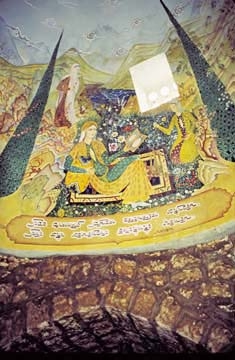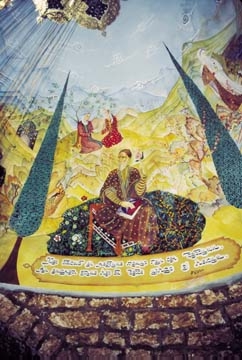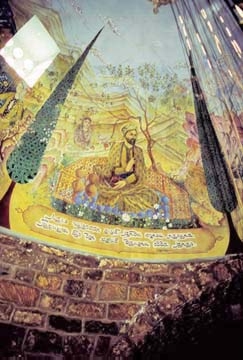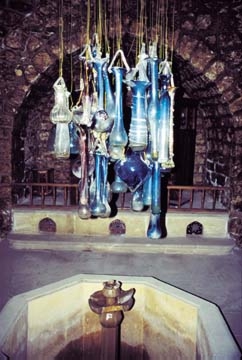
Summer
2000 (8.2)
Ancient Prescriptions
for Health
The Aptek
Museum and Bathhouse
by
Farid Alakbarov

Photo: Exterior of the Aptek
Museum Bathhouse located in Ichari Shahar (Inner City). Photo:
Litvin
It's one of those rare, unique places in Baku's "Inner City"
(Ichari Shahar), but it has fallen into such serious disrepair
that unless serious steps are taken to remedy this small bathhouse
museum that doubles as a pharmacy for traditional medicine, no
doubt it will have to be shut down. Most of the very attractive
murals in the dome entrance have already deteriorated, as the
building periodically suffers from both rains and underground
dampness. Most of the rooms have been closed. You can no longer
see the halls or bathhouse pools.
Many of the original exhibits have been removed to drier climes.
You'll still find an exhibit of ancient bottles and some old
documents. In 1990, there was an ancient balance used for measuring
very small seeds and tablets. It's gone now.


Murals inside
the entrance dome of the bath house are based on poetic lines
from (left) Mahsati Ganjavi and (right) Fuzuli. Below: (left)
Hippocrates and (right) Khagani. Photos: Blair


Nevertheless, we still think the museum and bathhouse are worth
a visit as you meander around in the medieval alleys of this,
the oldest section of Baku. Clearly this small museum was more
beautiful a decade ago, but still a visit offers a walk back
through medical time. It used to be that the pharmacists wore
national costumes; today you'll find them in white medical smocks.

 _____
_____
Baku's Aptek Museum - the "Banovsha" (Violet) - is
truly a novelty. Not only is it a renovated 17th-century bathhouse
but it's a museum of pharmacy as well, and there's actually a
pharmacy there where you can buy traditional herbal medicine
(phytopharmacy). The place also goes by the name "Green
Drug Store" (Yashil Aptek).
The Aptek Museum was created in 1984 when Baku's GAPU (Russian:
Glavne Aptek Upravleniya) (Azeri: Baki Shahar Bash Aptek Idarasi),
which in English means the Head Administration of Chemists' Shops,
decided to repair a medieval bathhouse. Twenty years ago, there
was a large square on the location where the museum now stands.
When archeologists began to excavate the area, they found the
ruins of a 17th-century bathhouse. The GAPU decided to convert
it into a museum of pharmacy as well.
Left: Display of early bottles
used for pharmaceutical purposes on display at the Aptek Bathhouse
Museum. Photo: Blair
Violet Remedies
Under the museum's name at the entrance is the word "Banovsha"
(violet), which refers to herbal medicine. Ancient manuscripts
provide evidence that during the 9th-14th centuries, the essential
oils of 42 species of herbs and flowers were used for treatments
in Azerbaijan. Violet oil was used to treat colds, inflammatory
disease, fever and especially headaches. One miniature from the
15th century shows a Turkish ruler, Sultan Mehmet, holding a
violet in his hands and smelling it. Perhaps the illustration
was simply purporting the best known remedy for a bad headache.
According to the medical manuscript "Jam' al-Bagdadi"
("The Baghdad Collection", 1311), written by Azerbaijani
scientist Yusif bin Ismayil Khoyi, violets were used to stop
headaches: "The scent of violets is healthy for treating
headaches that are caused by excessive bile in the organis. Massage
the head with a few drops of violet oil." A person with
a fever was encouraged to drink a sweet beverage (sharbat) made
of sugar and boiled violet leaves. Violet oil was also part of
the special salves that were used to heal ulcers and tumors.
Medieval Bathhouses
The bathhouse in which the museum is housed once belonged to
Gasim bey ("bey" a respectful term for landowner).
There were several such public bathhouses like this in Baku,
the largest one being built in the 16th century behind the Maiden's
Tower. The Shirvanshah Palace within the perimeters of the "Inner
City" (Ichari Shahar) also had a large bathhouse dating
from the 15th century, but it lies in ruins now.
Medieval Azeri sources attribute great healing properties to
bathing. An 11th-century writer named Keykavus ibn Isgandar wrote:
"Since architects first began to raise buildings, they have
not created anything better than a bathhouse."
In order to maintain good health, it was recommended that a person
visit a bathhouse at least two or three times each week. Medieval
authors suggested several plants to use in one's bath, including
grape leaves, chamomile, pomegranate, basil, anise, violet, almond,
garlic and barley.
All public bathhouses had masseurs who applied healing and aromatic
oils on the visitors' bodies. It was also possible to get meals,
drinks and medicine, and you could even rest or sleep in the
bathhouse. To treat a cold, the bathhouse would offer a formula
like the following: "Take 20g of basil leaves and flowers,
mix with 20g of thyme leaves, and infuse in 1 liter of hot water
for 15 minutes. Add two spoons of honey to the infusion and stir.
The diseased person has to take one spoon of this medicine every
half hour."
Gasim bey's bathhouse doesn't look like modern bathhouses or
saunas because it was based on the Oriental style of architecture,
which uses domes and arches. It has several large pools and a
number of separate rooms for individual bathing.
Medieval Medicine
Cabinet
In keeping with the site's healthfulness, various displays in
the Aptek Museum represent the history of pharmacy in the East.
On exhibit are ancient documents about the history of drugstores
in Azerbaijan, bottles that were used for storing herbal medicine
as well as scales and mortars for grinding medicinal plants.
It appears that even 1,000 years ago pharmacists had scales and
balances to measure seeds precisely, even as tiny as 1/100 gram.
A pharmacy from those times wasn't as primitive as we might imagine.
Azerbaijani pharmacists used 27 types of complex medicines during
the Middle Ages, including various unguents, powders, syrups,
tablets, concoctions, infusions and fresh juices. A total of
866 formulas for such complex medicines are described in the
ancient Azeri manuscripts. Medieval pharmacists in Azerbaijan
had a wide variety of ingredients to draw from, including 744
species of plants, 150 animals and 115 different minerals.
Another important aspect of the Aptek Museum building is the
beautiful murals on the ceiling of its entrance dome. When the
bathhouse was restored, the GAPU invited painter Tahir Tahirzade
to paint the walls and ceiling in the Oriental style. Tahirzade
created pastel images that imitated scenes from the Middle Ages
based on the style of the famous Azerbaijani miniaturists Sultan
Mohammad and Agha Mirak. Most of the scenes are literary, not
medical, and offer a glimpse into what was perceived as the idyllic
days of yore.
Outside, there's the new building of the Cultural Department
of the British Embassy. Of course, this brings with it congested
traffic. You can catch a good glimpse of the President's Aparat
from there as well.
Aptek Museum
Across from the Elf Office Building, southwest corner of Ichari
Shahar (Inner City) off V. Mammadov Street.
As a Medical
Historian at Baku's Institute of Manuscripts, Farid Alakbarov
has extensively studied the medieval medicine texts preserved
at the Manuscript Museum in their original Arabic script .
Home
| About
Azeri | Learn
Azeri | Arabic
Script | Store | Contact
us
Articles from Azerbaijan
International
© Azerbaijan International. Copyright 2002. All rights reserved.
|
|
 |
 |
Murals inside the entrance dome of the bath house are based on poetic lines from (left) Mahsati Ganjavi and (right) Fuzuli. Below: (left) Hippocrates and (right) Khagani. Photos: Blair
 |
 |
Nevertheless, we still think the museum and bathhouse are worth a visit as you meander around in the medieval alleys of this, the oldest section of Baku. Clearly this small museum was more beautiful a decade ago, but still a visit offers a walk back through medical time. It used to be that the pharmacists wore national costumes; today you'll find them in white medical smocks.

![]() _____
_____
Baku's Aptek Museum - the "Banovsha" (Violet) - is
truly a novelty. Not only is it a renovated 17th-century bathhouse
but it's a museum of pharmacy as well, and there's actually a
pharmacy there where you can buy traditional herbal medicine
(phytopharmacy). The place also goes by the name "Green
Drug Store" (Yashil Aptek).
The Aptek Museum was created in 1984 when Baku's GAPU (Russian:
Glavne Aptek Upravleniya) (Azeri: Baki Shahar Bash Aptek Idarasi),
which in English means the Head Administration of Chemists' Shops,
decided to repair a medieval bathhouse. Twenty years ago, there
was a large square on the location where the museum now stands.
When archeologists began to excavate the area, they found the
ruins of a 17th-century bathhouse. The GAPU decided to convert
it into a museum of pharmacy as well.
Left: Display of early bottles
used for pharmaceutical purposes on display at the Aptek Bathhouse
Museum. Photo: Blair
Violet Remedies
Under the museum's name at the entrance is the word "Banovsha"
(violet), which refers to herbal medicine. Ancient manuscripts
provide evidence that during the 9th-14th centuries, the essential
oils of 42 species of herbs and flowers were used for treatments
in Azerbaijan. Violet oil was used to treat colds, inflammatory
disease, fever and especially headaches. One miniature from the
15th century shows a Turkish ruler, Sultan Mehmet, holding a
violet in his hands and smelling it. Perhaps the illustration
was simply purporting the best known remedy for a bad headache.
According to the medical manuscript "Jam' al-Bagdadi"
("The Baghdad Collection", 1311), written by Azerbaijani
scientist Yusif bin Ismayil Khoyi, violets were used to stop
headaches: "The scent of violets is healthy for treating
headaches that are caused by excessive bile in the organis. Massage
the head with a few drops of violet oil." A person with
a fever was encouraged to drink a sweet beverage (sharbat) made
of sugar and boiled violet leaves. Violet oil was also part of
the special salves that were used to heal ulcers and tumors.
Medieval Bathhouses
The bathhouse in which the museum is housed once belonged to
Gasim bey ("bey" a respectful term for landowner).
There were several such public bathhouses like this in Baku,
the largest one being built in the 16th century behind the Maiden's
Tower. The Shirvanshah Palace within the perimeters of the "Inner
City" (Ichari Shahar) also had a large bathhouse dating
from the 15th century, but it lies in ruins now.
Medieval Azeri sources attribute great healing properties to
bathing. An 11th-century writer named Keykavus ibn Isgandar wrote:
"Since architects first began to raise buildings, they have
not created anything better than a bathhouse."
In order to maintain good health, it was recommended that a person
visit a bathhouse at least two or three times each week. Medieval
authors suggested several plants to use in one's bath, including
grape leaves, chamomile, pomegranate, basil, anise, violet, almond,
garlic and barley.
All public bathhouses had masseurs who applied healing and aromatic
oils on the visitors' bodies. It was also possible to get meals,
drinks and medicine, and you could even rest or sleep in the
bathhouse. To treat a cold, the bathhouse would offer a formula
like the following: "Take 20g of basil leaves and flowers,
mix with 20g of thyme leaves, and infuse in 1 liter of hot water
for 15 minutes. Add two spoons of honey to the infusion and stir.
The diseased person has to take one spoon of this medicine every
half hour."
Gasim bey's bathhouse doesn't look like modern bathhouses or
saunas because it was based on the Oriental style of architecture,
which uses domes and arches. It has several large pools and a
number of separate rooms for individual bathing.
Medieval Medicine
Cabinet
In keeping with the site's healthfulness, various displays in
the Aptek Museum represent the history of pharmacy in the East.
On exhibit are ancient documents about the history of drugstores
in Azerbaijan, bottles that were used for storing herbal medicine
as well as scales and mortars for grinding medicinal plants.
It appears that even 1,000 years ago pharmacists had scales and
balances to measure seeds precisely, even as tiny as 1/100 gram.
A pharmacy from those times wasn't as primitive as we might imagine.
Azerbaijani pharmacists used 27 types of complex medicines during
the Middle Ages, including various unguents, powders, syrups,
tablets, concoctions, infusions and fresh juices. A total of
866 formulas for such complex medicines are described in the
ancient Azeri manuscripts. Medieval pharmacists in Azerbaijan
had a wide variety of ingredients to draw from, including 744
species of plants, 150 animals and 115 different minerals.
Another important aspect of the Aptek Museum building is the
beautiful murals on the ceiling of its entrance dome. When the
bathhouse was restored, the GAPU invited painter Tahir Tahirzade
to paint the walls and ceiling in the Oriental style. Tahirzade
created pastel images that imitated scenes from the Middle Ages
based on the style of the famous Azerbaijani miniaturists Sultan
Mohammad and Agha Mirak. Most of the scenes are literary, not
medical, and offer a glimpse into what was perceived as the idyllic
days of yore.
Outside, there's the new building of the Cultural Department
of the British Embassy. Of course, this brings with it congested
traffic. You can catch a good glimpse of the President's Aparat
from there as well.
Aptek Museum
Across from the Elf Office Building, southwest corner of Ichari
Shahar (Inner City) off V. Mammadov Street.
As a Medical
Historian at Baku's Institute of Manuscripts, Farid Alakbarov
has extensively studied the medieval medicine texts preserved
at the Manuscript Museum in their original Arabic script .
Home
| About
Azeri | Learn
Azeri | Arabic
Script | Store | Contact
us
Articles from Azerbaijan
International
© Azerbaijan International. Copyright 2002. All rights reserved.